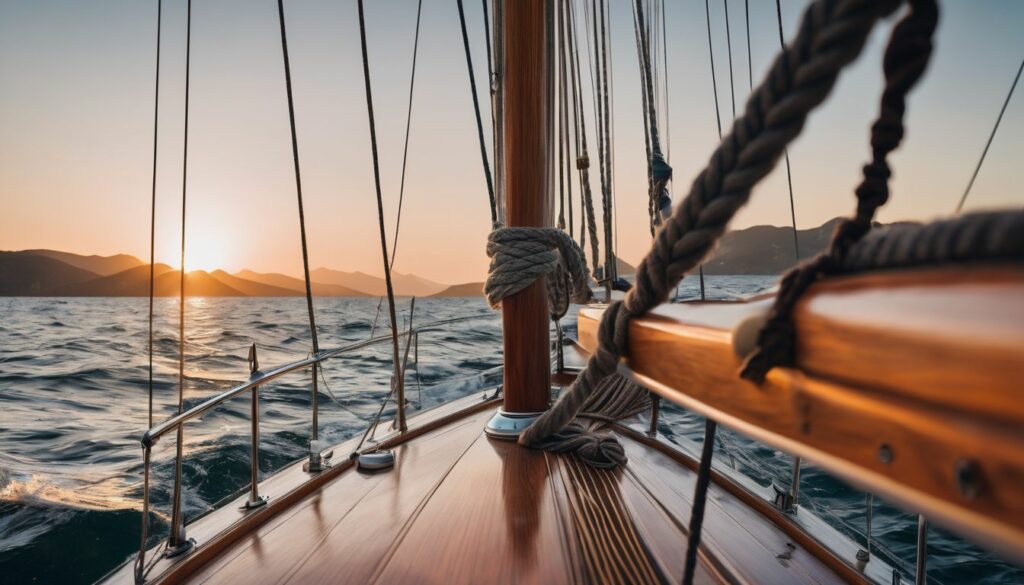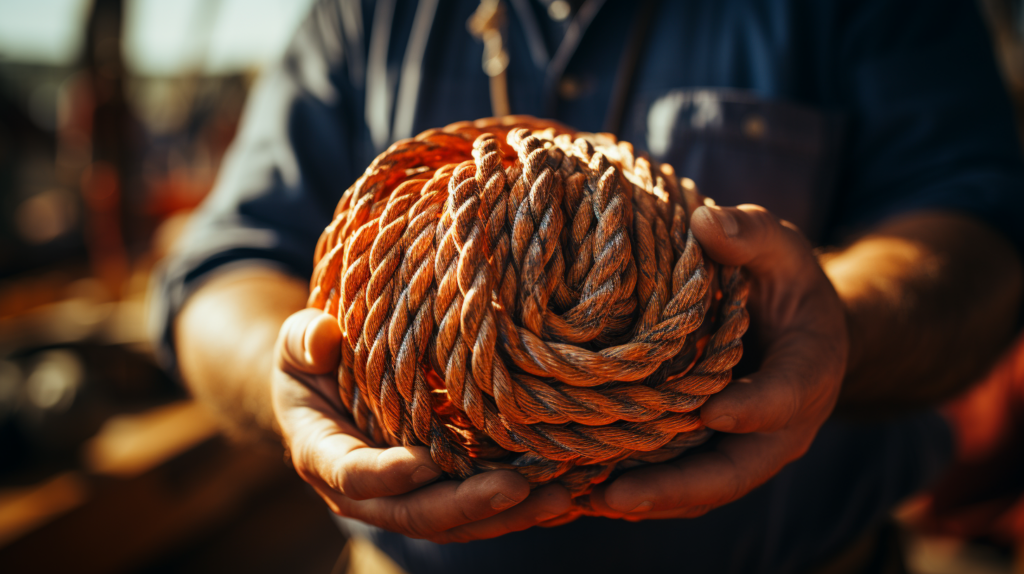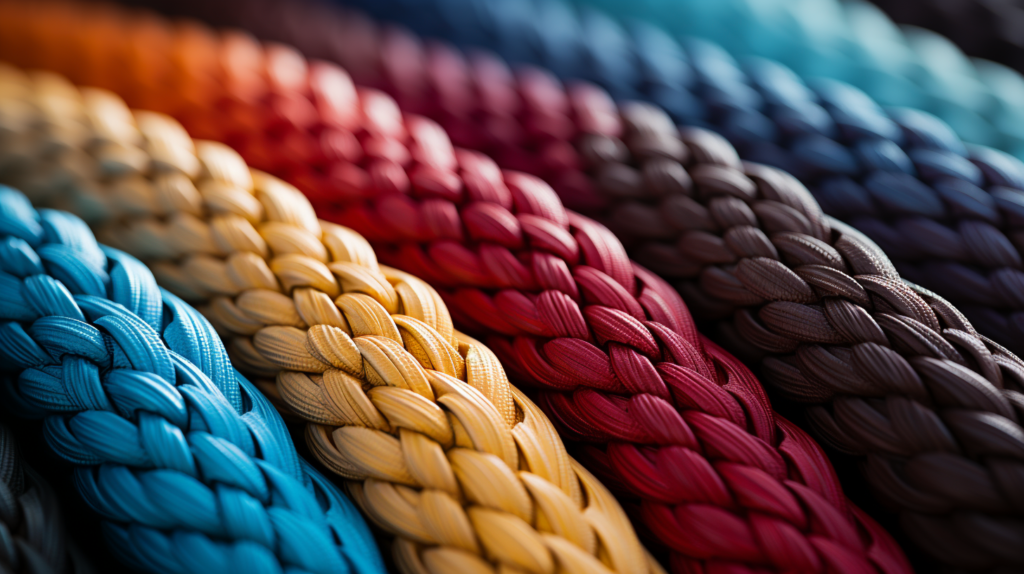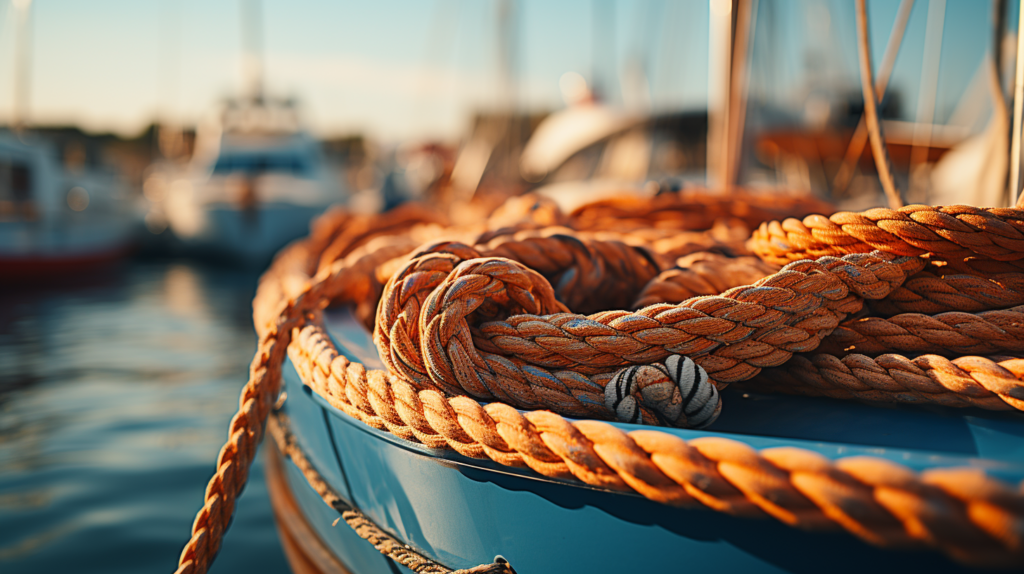Table of Contents
Table of Contents

Sailing is full of challenges, and choosing the right lines for your boat can certainly be one of them. With so many types from polyester to high-tech synthetic fibers like Kevlar or Spectra, it’s easy to feel overwhelmed.
This article breaks down everything you need to know about sailing lines – from understanding different rope types to offering tips on how to extend their lifespan. Ready? Dive in!
Key Takeaways
- Different types of sailing lines like nylon, polypropylene, and polyester have their pros and cons based on features like strength, UV resistance, and water absorbency.
- The use of the sailing line determines what material is best. For example, main halyards need strong, low-stretch ropes while control lines benefit from lightweight materials.
- Color coding in sailing lines can make it easier for sailors to identify different ropes quickly and under different lighting conditions.
- Proper care of your sailboat ropes boosts their lifespan. This includes storing them correctly and protecting them from harmful elements such as chemicals or direct sunlight.
- When buying dock lines consider factors like size, length, and quantity needed based on your boat’s dimensions plus additional accessories for extra protection.
Understanding the Different Types of Rope Fibers

Sailing lines are constructed from various types of fibers, including nylon known for its elasticity and shock absorbency; polypropylene which is lightweight and floats on water; and polyester which strikes a balance with good strength, low stretch, and UV resistance.
Nylon
Nylon holds a place of prominence in the world of sailing, with good reason. This robust material shows off its strength by maintaining integrity under high loads. Its standout feature – the ability to stretch and absorb shock makes it ideal for lines where sudden stress may occur, offering a margin of safety to sailors.
It endures abrasion and UV radiation remarkably well increasing its lifespan on your sailboat. A bonus is nylon’s resistance against chemicals; not to mention, handling these ropes comes easily even under wet conditions!
Polypropylene
Polypropylene ropes have a unique place in the boating world. This type of line, often recognized as “yellow rope,” is commonly utilized for towing duties due to its buoyant nature, allowing it to conveniently float on water surfaces.
Its bright color and floating feature make it a favorite among sailors who enjoy water sports such as skiing or wakeboarding.
Despite these advantages, polypropylene has distinct drawbacks related to UV resistance and longevity. Exposure to sunlight degrades the strength of these ropes over time, shortening their lifespan compared to other line materials.
Consequently, frequent replacement may be necessary if the rope starts showing signs of wear and tear due to UV rays or general aging.
Polyester
Polyester sailing lines boast strength and durability, making them a reliable choice for many sailors. The initial stretch of polyester rope is significant but it continues to elongate over time, compromising its low-stretch line attribute.
Sailors should note that this heavy-duty rope tends to absorb water which might make handling challenging during high-load applications. Unfortunately, despite its robust nature, polyester has poor resistance against abrasion and has a relatively lower breaking strength in comparison with ropes of similar diameter.
Its susceptibility to UV rays also contributes to the faster aging and wear and tear of the sailing line.
Identifying the Right Sailing Lines for Different Uses

When choosing sailing lines, it’s crucial to consider their specific uses such as the main halyard and jib/genoa halyard for raising sails, the spinnaker halyard for flying a spinnaker, mainsheet, and jib/genoa sheet for adjusting sail trim, spinnaker sheets for handling the spinnaker during downwind courses, and control lines like vangs and travelers that adjust tension on various parts of your rigging.
Main Halyard and Jib/Genoa Halyard
The main halyard and jib/genoa halyard are crucial components of your sailboat rigging. These ropes must withstand heavy loads and have low stretch to properly control the sails. You can choose among several types of rope for these lines, each with its unique properties.
Polyester rope is widely used due to its strength and durability. However, it’s heavier and absorbs more water over time compared to other materials like Aramid or Liquid Crystal Polymer (Vectran®) ropes that offer excellent heat resistance, high break strength, and minimal elongation under load.
Consider the specific needs of your sailing rig before purchasing a rope for this purpose.
Spinnaker Halyard
Spinnaker halyards demand ropes with high break strength and low stretch to handle the sail’s weight and wind pressure. Many sailors opt for a Polyester rope; its durability, low-stretch properties, and strength make it a go-to choice for this purpose.
It can withstand harsh weather conditions while maintaining its integrity.
Some spinnaker halyard lines employ aramid ropes like Technora®, Twaron®, or Kevlar® as they resist heat well and exhibit commendable durability under tension. Liquid Crystal Polymer (Vectran®) is another favored material since it doesn’t absorb water, making your line lighter and easier to manage on deck.
HMPE (Spectra®, Dyneema®), despite having a higher price point, justifies its use with excellent heat resistance, superior elongation control, and unmatched break strength.
Mainsheet
The mainsheet is the line you’ll rely on to make significant adjustments to your sail’s angle relative to the wind. This crucial rope connects your boom to the deck, allowing sailors direct control over their boat’s speed and sailing direction.
Mainsheets must exhibit a high level of tensile strength and have minimal stretch, as they continually experience a lot of load during any sailing journey. Sailors often prefer ropes made from durable materials like Polyester or HMPE (such as Spectra® or Dyneema®) for their mainsheets due to these materials’ excellent balance between strength and resistance against wear and tear.
By opting for top-quality mainsheet material, you guarantee an efficient sailing experience while ensuring that safety remains paramount at all times.
Jib/Genoa Sheet
Understanding the functionality of a Jib/Genoa Sheet plays a vital role in effective sailing. These sheets are utilized to control the jib or genoa sail’s angle relative to wind direction on a sailboat.
The selection of these lines is crucial as they must have low-stretch characteristics, ensuring efficient energy transfer from the sails down through the hull into forward motion. Sheets like Spectra® or Vectran®-based rope fulfill this purpose and offer advantages such as reduced elongation under load and superior abrasion resistance for longevity.
For high-load applications on larger cruising vessels, blended double braid Beltran® or Spectra® rope serves ideally while club racing demands Vectran® or Spectra®, facilitating higher load handling capacity.
Spinnaker Sheet
Spinnaker sheets demand a low-stretch line due to their high-load applications. This specific sailboat rigging type is essential for maneuvering the spinnaker, a large triangular sail at the front of the boat.
Quantum Sails and New England Ropes are popular choices amongst sailors for their superior break strength and UV resistance properties. Always opt for a robust material like Spectra® or Dyneema® as they’re designed to withstand significant abrasion resistance, making them ideal for use with deck fitting on your sailing vessel.
It’s also worthwhile noting that color coding your spinnaker sheet makes it easier to manage amidst other control lines during hectic sailing conditions.
Control Lines
Dyneema® and Vectran® ropes are among the top choices for control lines. Even though Dyneema® tends to creep slowly over time, it’s an excellent choice due to its high strength.
Vectran®, on the other hand, is extremely low-stretch and lightweight, making it ideal for this role as well.
Selecting an Aramid or Polyester type rope can also serve you well. With Polyester known for its strength, durability, and low stretch capacity, it’s aptly suited for withstanding frequent adjustments under load – typical of most control line applications.
Moreover, aramid ropes offer great heat resistance along with substantial strength properties that make them viable contenders in crafting reliable control lines.
The Importance of Color Coding in Sailing Lines

Color coding in sailing lines plays a crucial role, in enhancing both navigation and safety. It carves an identity for each line according to its function, making it easier for sailors to distinguish between them quickly.
Imagine being out on the waters with every second counting; color-coded halyards, sheets, and control lines can be life-savers!
Furthermore, properly chosen colors can go a long way in boosting visibility. Using bright and contrasting hues is beneficial, especially under different lighting conditions or various parts of the boat.
This system not only ensures efficient operations but also acts as a visual guides for beginners learning about sail rigging or less experienced sailors looking to reinforce their skills.
Lastly, while choosing colors for sailing ropes like Spectra® or Dyneema®, considering compatibility with other equipment on deck can promote seamless operation while out at sea.
Tips for Extending the Life of Your Sailing Lines

Maintaining your sailing lines is crucial for their longevity and performance. Here are a few tips to help extend their life:
- Utilize Polyester (PET) rope for its strength, durability, and low stretch.
- Consider using Aramid ropes like TECHNORA®, TWARON®, and KEVLAR® for their high heat resistance and minimal stretch.
- Opt for Liquid Crystal Polymer (Vectran®) rope if you need low-stretch, lightweight lines that don’t absorb water.
- Choose HMPE ropes as Spectra®, and Dyneema® have excellent heat resistance and break strength.
- Always store your ropes in a clean, dark place at room temperature with controlled humidity levels.
- Protect your ropes from excessive load, friction, chemicals, dirt, and UV rays to prevent degradation.
- Regularly inspect your lines and replace them when signs of wear become apparent.
Considerations when Buying Dock Lines
When buying dock lines, it’s crucial to consider their size and length based on your boat’s dimensions. The number of dock lines needed should also be assessed depending on the docking style and conditions you’ll encounter.
Don’t forget to look into add-on accessories like snubbers and chafe guards for additional durability and protection against wear and tear. Always opt for high-quality materials that can withstand prolonged exposure to elements like UV rays and saltwater for a longer lifespan of your lines.
Size and Length
Knowing the correct size and length for your dock lines is crucial. The diameter of a line should be selected based on the size of your boat. For instance, if your boat’s length ranges from 20 to 30 feet, you’ll likely need a rope with a diameter between 3/8 to 1/2 inch.
Length also plays an essential role when it comes to dock lines. Your bow and stern lines should be at least two-thirds of your boat’s overall length, while spring lines ought to equal the full length or more.
This allows the necessary flexibility for tidal changes and other movements that can affect how securely anchored your vessel stays over time.
Quantity Needed
Establishing the correct quantity of dock lines for your sailboat contributes significantly to its overall safety and functionality. This count typically includes two bow lines, two stern lines, and at least two spring lines.
These ropes perform their set roles to secure the boat firmly when docked – so it’s crucial not to skimp on them. Moreover, having some extra available is handy during unexpected situations or emergencies.
The size of your boat and docking conditions may demand more than this basic setup; consult with experienced sailors or boating professionals if uncertain about your specific needs.
Accessories: Snubbers and Chafe Guards
Investing in accessories like snubbers and chafe guards can significantly extend the lifespan of your dock lines. Here are some key points to consider:
- Snubbers: These handy devices absorb shock and prevent sudden jolts from damaging dock lines or boats. Sailors often use them during rough weather conditions to ensure the safety of their vessels.
- Chafe Guards: Dock lines frequently rub against rough surfaces, leading to abrasion and potential damage. Chafe guards protect these lines by providing a robust barrier between the line and any harsh surface it may come into contact with.
Conclusion
Making the right choice in sailing lines is crucial for both safety and performance on the water. It’s not just about picking any rope, but understanding what your specific needs are, from the type of sailing to resistance requirements.
So choose wisely, because a well-equipped sailboat enhances your control over the waters and lets you enjoy smoother sailing journeys.
FAQs
1. What are the different types of sailboat rigging?
Sailboat rigging types include control lines, mainsheet rigging, running rigging, and boat lines or ropes used for setting up sailboat rigs.
2. How do I choose the right sailing line for my boat?
To choose the correct sailing line you need to consider factors like rope strength, rope’s aging, wear and tear resistance, sheave and winch compatibility along with your intended usage like towing skiers or anchoring techniques, etc.
3. Can you name some popular sailing lines in the market?
Popular brands include STA-SET, T-900, V-100, Nexus Pro, Poly Tec, Salsa Line, Bzzz line, and Endura Braid among others; they offer a variety of products suited to distinct purposes such as Grand Prix racing or everyday boating life.
4. What should I know about sailing rope construction before buying one?
You should understand their construction: whether it is three-strand braided, double braided, polyester braid, or all-rope halyards along with understanding the difference between nylon rope and Beltran® rope which can affect knotting ability, color coding strength as well as UV sunlight resistance
5. What Is Rope-to-Wire Splice technique allotment done on boats?
The Rope-to-wire splice technique is used when scraping paint or anodizing from a mast where ultra-low stretch fiber wire connects to a more flexible rope section.
6. How does BoatUS Boating Association suggest maintaining docklines lifespan?
According to BoatUS Boating Association, to prolong any dock line lifespan regular inspection needs to be done followed by proper cleaning methodologies and safeguarding against knots, kinks in line, sunlight exposure, and rectifying wear and torn parts regularly.
7. What are halyards and sheets?
Halyards and sheets are essential sailing lines used on a yacht. Halyards are ropes that raise and lower the sails, while sheets are used to control the sails’ position.
8. What is halyard rope?
Halyard rope refers to the specific type of rope used for halyards. It needs to have the right combination of strength, flexibility, and resistance to withstand the demands of hoisting and lowering sails.
9. What is a nylon halyard?
A nylon halyard is a type of halyard made from nylon material. Nylon is durable, flexible, and has excellent shock absorption properties, making it suitable for various sailing applications.
10. What types of boat ropes are commonly used for halyards?
The most common types of boat ropes used for halyards are nylon ropes and high-performance ropes like Dyneema. Nylon ropes are durable and affordable, while Dyneema ropes offer high strength and low stretch.
11. How do I choose the right rope?
Choosing the right rope involves considering factors such as the intended use, strength requirements, and desired performance characteristics. Factors like material, construction, and diameter should be taken into account when selecting a sailing line.
12. How can I prevent chafe on my sailing lines?
To prevent chafes, you can use protective covers, such as leather or fabric sleeves, or apply chafe guards made of strong materials like Kevlar.
13. How do I choose the right rope for sailing?
When choosing a rope for sailing, you should consider factors such as strength, stretch, durability, and cost. Nylon ropes are suitable for most applications, while high-performance ropes like Dyneema are ideal for racing or performance-oriented sailors.
14. What are mooring lines used for?
Mooring lines are ropes used to secure a boat to a dock, buoy, or anchor. They ensure the boat remains in place and prevent drifting or damage caused by shifting tides or currents.
15. What is a cleat?
A cleat is a device used to secure a line on a boat. It provides a strong point to which a line can be tied or fastened.
16. How important is the strength of the line?
The strength of the line is crucial in sailing as it determines its ability to withstand the forces exerted on it. It is vital to have strong and durable lines to ensure safety and reliability.
17. What are anchor lines?
Anchor lines, also known as anchor rode, are ropes used to secure a yacht or boat in place when anchoring. They provide stability and hold the vessel in position.
18. What is Dyneema?
Dyneema is a high-performance synthetic fiber known for its exceptional strength and low weight. It is often used in the construction of high-performance sailing lines due to its superior properties.
19. How does the choice of sailing lines affect the yacht?
The choice of sailing lines can greatly impact the yacht’s performance, safety, and overall sailing experience. Using the right lines with appropriate strength, flexibility, and durability ensures smooth control of the sails and enhances the yacht’s maneuverability.

